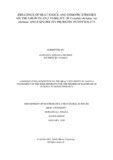| dc.contributor.advisor | Hossain, Mahboob | |
| dc.contributor.advisor | Bhuiyan, Mohammad Nazrul Islam | |
| dc.contributor.author | Promee, Jannatul Sumaiya | |
| dc.date.accessioned | 2021-03-14T06:26:27Z | |
| dc.date.available | 2021-03-14T06:26:27Z | |
| dc.date.copyright | 2020 | |
| dc.date.issued | 2020-01 | |
| dc.identifier.other | ID: 15136022 | |
| dc.identifier.uri | http://hdl.handle.net/10361/14342 | |
| dc.description | This thesis is submitted in partial fulfilment of the requirements for the degree of Bachelor of Science in Biotechnology 2020. | en_US |
| dc.description | Catalogued from PDF version of thesis. | |
| dc.description | Includes bibliographical references (pages 37-40). | |
| dc.description.abstract | Live microorganisms with health benefits termed as probiotics, commercialized in the market to provide the health benefits to host. However, most probiotics are bacteria but very recently Saccharomyces boulardii, a yeast commercialized in the market. Yeasts also carry probiotic potentiality which is beneficial to our health but yet to be commercialized. The present study emphasizes how a yeast strain functions in critical growth temperature and under osmotic stress. This paper also analyzes the in vitro probiotic activity of the yeast strain. This study started with the isolation of yeast from a cheddar cheese sample. Identification was done by BIOLOG which is a very recent and easy microbial identification system. Isolated yeast Candida shehatae var shehatae showed its optimum growth in SDA (Sabouraud dextrose agar) medium at 32.5°C. To determine the critical growth temperature of Candida shehatae var shehatae growth was monitored at 40 °C and 45°C for 72 hours. Osmotic stress tolerance was observed at 32.5°C in different dextrose (0.04 g/l (1X), 0.12 g/l (3X), 0.2 g/l (5X), 0.28 g/l (7X), 0.36 g/l (9X) ) and sucrose, i.e., 0.02 g/l (1X), 0.06 g/l (3X), 0.1 g/l (5X), 0.14 g/l (7X), and 0.18 g/l (9X) concentrations. The yeast strain found to be tolerant at high 45°C but reached its dormant phase after that. Gastric acid and bile salt tolerance test was done to find out the probiotic activity. Freshly prepared gastric juice at different pH levels and (0.1%, 0.55, 1%) bile salt was prepared and the result was monitored at 600 nm at different time intervals. The viability of strains was analyzed by determination of CFU/ml. Candida shehatae var shehatae showed high absorbance at pH 3 and 3.5 in terms of gastric juice tests. It also had shown the best ability to tolerate bile salts and had a good growth rate even at 1% bile salt. However, only two in vitro tests had done to find out the probiotic activity. Hence, more in vitro and in vivo tests should be done to establish the yeast strain as a good probiotic. | en_US |
| dc.description.statementofresponsibility | Jannatul Sumaiya Promee | |
| dc.format.extent | 41 pages | |
| dc.language.iso | en_US | en_US |
| dc.publisher | Brac University | en_US |
| dc.rights | Brac University theses are protected by copyright. They may be viewed from this source for any purpose, but reproduction or distribution in any format is prohibited without written permission. | |
| dc.subject | Candida | en_US |
| dc.subject | Osmotic pressure | en_US |
| dc.subject | BIOLOG | en_US |
| dc.subject | Dextros | en_US |
| dc.subject | Sucrose | en_US |
| dc.subject | Gastric acid | en_US |
| dc.title | Influence of heat shock and osmotic stresses on the growth and viability of Candida shehatae var shehatae and explore its probiotic potentiality | en_US |
| dc.type | Thesis | en_US |
| dc.contributor.department | Department of Mathematics and Natural Sciences, Brac University | |
| dc.description.degree | B. Biotechnology | |

